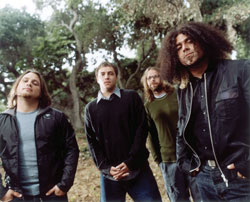Although Coheed and Cambria’s freshly released sequel album in The Afterman series might be labeled Descension, this musical composition is proving to be far from a decline.
Coheed and Cambria, composed of lead vocalist and guitarist Claudio Sanchez, lead guitarist Travis Stever, drummer Josh Eppard, and bassist Zach Cooper, is recognizable to many and is usually found as a curious oddity amongst the wide span of musical libraries.
Despite their beginnings in 1995 as metal-headed rock group with pop-punk habituals, the band seems to have finally found a stable identity as a progressive rock group in their Afterman project and is flying high as a result.
Things were not always as positive as they are currently for Coheed. They were initially thought to have reached the glass ceiling with their hit 2005 record Good Apollo, I’m Burning Star IV, Volume One: From Fear Through the Eyes of Madness and with the assistance of chart-topping singles such as “Welcome Home,” “Ten Speed (Of Gods Blood and Burial),” and “The Suffering.” Through critical opinion the band fell down with their following two albums, appearing to have run out of creative compositions with the 2010 release Year of the Black Rainbow. But with The Afterman, Coheed appears to be setting aside any past inhibitions and melodic faux pas.
Continuing the story from their previous album, Afterman: Ascension, Descension follows Sanchez’s tale of astronaut Sirius Amory in his manufactured realm of “The Amory Wars.” Set in a futuristic time place where an abnormal energy mass known as the Keywork thrives, Amory explores the curious unknown beyond that of any other; soon discovering that the Keywork is actually a holding cell where all spirits go after their time expires on Earth.
Arguably their most challenging album to date, with the story behind the music being difficult to follow without knowing the events within the tale, Coheed showcases their pristine story-telling capabilities nonetheless by depicting the tale of Amory.
Upon first glance, Descension gives the impression of a more upbeat tune as opposed to Ascension; not lyrically but with beat and it’s combination of bluesy, New Orleanian and Latin rhythms. With powerhouse songs such as “Number City” and “The Hard Sell,” both of which morph the audience into a head-bobbing, foot-tapping mass, as well as the combination of trumpet, heavy bass, technologic sound warps, and shape-shifting vocals, Coheed and their famed complexities are presented beautifully.
However, contrast is presented in a manner to make one follow the shift in emotion as they listen; this occurs most prominently in track six, “Away We Go,” presenting a slower paced anthem, which ties into the rest of the series flawlessly despite its toned down ticks. At the same time, the song also plays tribute to rhythms very much reminiscent of music from the Good Apollo era, ensuring applause from old ‘Heed Heads’ and new alike.
Coheed dives into its self-made abyss a little deeper while playing with more than just beats. In their haunting ballad and break through single “Dark Side of Me,” the band brings emotional emphasis to a whole new level and aligns the audience with a tone most can identify with all through their manipulation of electronic theatrics and lyrical combinations.
To close out the album comes “2’s My Favorite 1” which serves as a decent vehicle of closure, wrapping up the album with its silver-line inducing metaphors. Although the album puts forth several heavy themes, such as exploring the reality of death or the push-pull effects of love, the set ultimately ends its tale on a high note for Sirius Amory and Coheed alike.
Taken as a whole, The Afterman series proves to be a unified work, complementary like a pair of twins.
Ascension is most obviously the green light allowing for Coheed to explore different spheres of musical influence while still staying at home in their progressive routes and permit for “The Amory Wars” sequence to be illustrated. However, Descension still houses some of the band’s strongest works to date.
The Afterman practically reeks with confidence, with its routes sprouting from Sanchez’s imaginative lyrics, Eppard’s energy, and the emphasis on high-low range brought on by Stever and Cooper. Not to mention the ballsy use of technologic robot voices, a persistent theme in the two albums-one which helps them accomplish the futuristic setting of “The Amory Wars.” It is all of the details that Coheed blend into their latest, and possibly greatest, composition that makes it amazing.
Admittedly, the excessive praise amounted in this review might be off putting to some or at least make a few skeptical to those who only faintly know the band from the hits they had in the past.
If anything, the well-written verses and complexities they simply call “tunes” should speak for themselves. High concept thought and forward thinking, whether in the form of music or storyline in Sanchez’s case, are what lie within this duel album. If that doesn’t gain Coheed any props in this high standard realm of music, then there is essentially no justice.




